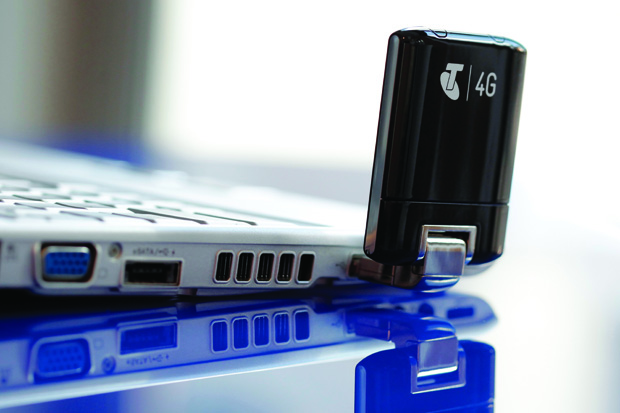Telstra's 4G LTE goes public

Telstra will today launch its "4G" long-term evolution (LTE) mobile network to consumers in all eight capital cities and 30 regional centres across Australia.

(Credit: Telstra)
Following a soft launch to around 2000 test and business customers at the end of August, Telstra will today open up its LTE network to consumers who sign up for a new 24-month plan with the new BigPond USB 4G dongle.
Telstra has indicated that typical download speeds will now be between 2 megabits per second (Mbps) and 40Mbps, with upload speeds of between 1Mbps and 10Mbps. This is an approximate doubling in download speeds, and a tripling of upload speeds, the telco told journalists in a briefing yesterday.
LTE will also bring about improved latency, around half of that of existing 3G technology.
In a demonstration to journalists yesterday, with eight laptops streaming high-definition videos over Telstra's LTE network through the one cell, the average download speed was 32.47Mbps, while the average upload speed was 18.53Mbps, with a latency of 32 milliseconds.
Telstra has deployed upgrades to base stations in all eight capital cities and 30 regional centres, and plans to expand this to approximately 80 regional locations by the end of 2011. Customers will be able to access the network within 5km of a capital city, and within 3km of a regional centre. Telstra has also deployed LTE upgrades in the airports of each capital city. View a list of all 80 sites here.
Spectrum
Telstra is utilising the 1800MHz spectrum band for the LTE roll-out, which was previously used by the company for 2G services. When customers are outside of the LTE network footprint, Telstra's director of network Anthony Goonan said that customers would roam to Next G.
"When a customer is in the 4G coverage areas, you're operating in 4G. When outside those areas, across the rest of the network ... you will seamlessly work across to our 3G high-speed packet-access network," he said.
The device will work using 1800MHz for LTE and 850MHz and 2.1GHz for 3G. The dongle is also set to work in the 2.6GHz spectrum band for LTE. Goonan explained that this was to align with international LTE standards for roaming purposes; however, for now, Telstra customers travelling overseas will only be able to roam to 3G. The dongle doesn't roam to the 700MHz spectrum band, which is set to be auctioned off at the end of next year for LTE networks. Goonan said that customers would have likely upgraded their devices by the time the spectrum had been auctioned and made use of.
While the 1800MHz spectrum band is not ideal for coverage and building penetration compared to Telstra's 850MHz Next G network, Bray said that the high number of base stations in CBD areas would mean that the speeds on offer would still be adequate.
"Because we have such a high concentration of base stations, we still have very good signal strength from the 1800MHz transmission, so in terms of distance [and] penetration into buildings, the performance of the LTE at 1800 is not dissimilar to the 3G technology," he said. "And we are enabling in-building systems with the LTE technology, as well."
As Telstra expands its LTE network, Goonan said that Telstra's engineering team would be monitoring Telstra's 7500 base stations to determine where the demand for LTE would be.
"We are monitoring them day in and day out, and looking at when they will approach their capacity limits, and then we expand those particular sites. So we either expand them using existing 3G technology, and then as 4G demand grows we will expand them with 4G technology," he said.
Pricing and products
The prices for plans will remain the same as those announced for regular mobile broadband plans earlier this month.
Customers who currently have an Ultimate BigPond USB dongle will be required to re-contract in order to get the 4G USB dongle, and Telstra has not yet offered the device for purchase outright for consumers; however, business customers can buy the device outright for $299.
Telstra's executive director of mobile Warwick Bray explained that pricing had been kept the same because Telstra "wanted to provide value to [its] customers", and to provide incentive to sign up to LTE.
"It's a great network for capacity as well, and we want to encourage people to come onto the 4G network."
The company also announced plans to launch the first 4G smartphone in Australia early next year: the HTC 4G. Bray indicated that the company's other device partners were working towards LTE smartphones, and he said that LTE tablet devices are also expected in the first half of 2012. Bray said that Telstra was investigating bringing its popular Wi-Fi hotspot device to 4G, but had no plans for launching it at this stage.
When the 4G USB dongle is launched, Telstra will discontinue its Ultimate Next G broadband USB dongle product, selling off the remaining units to consumer and enterprise customers.